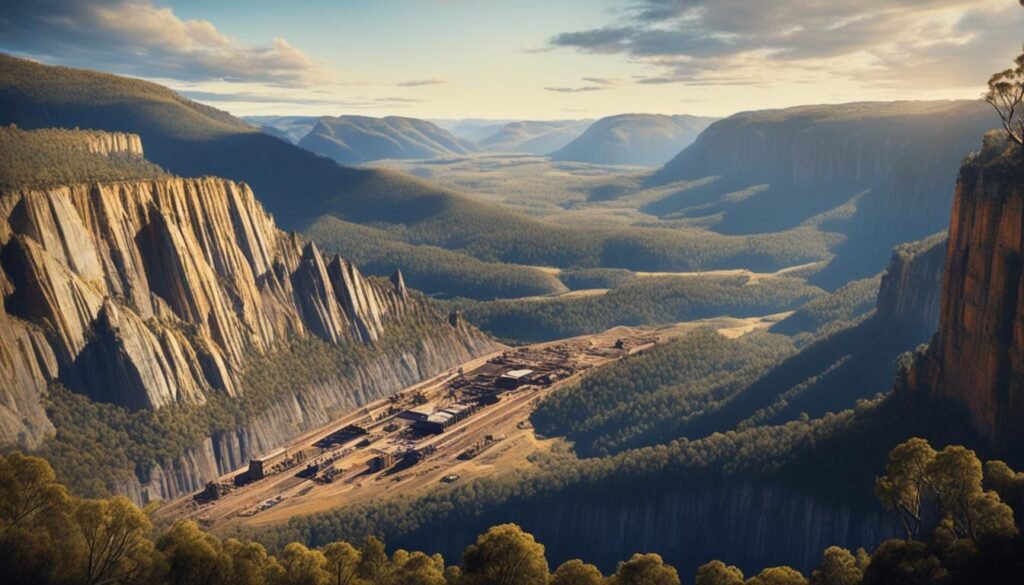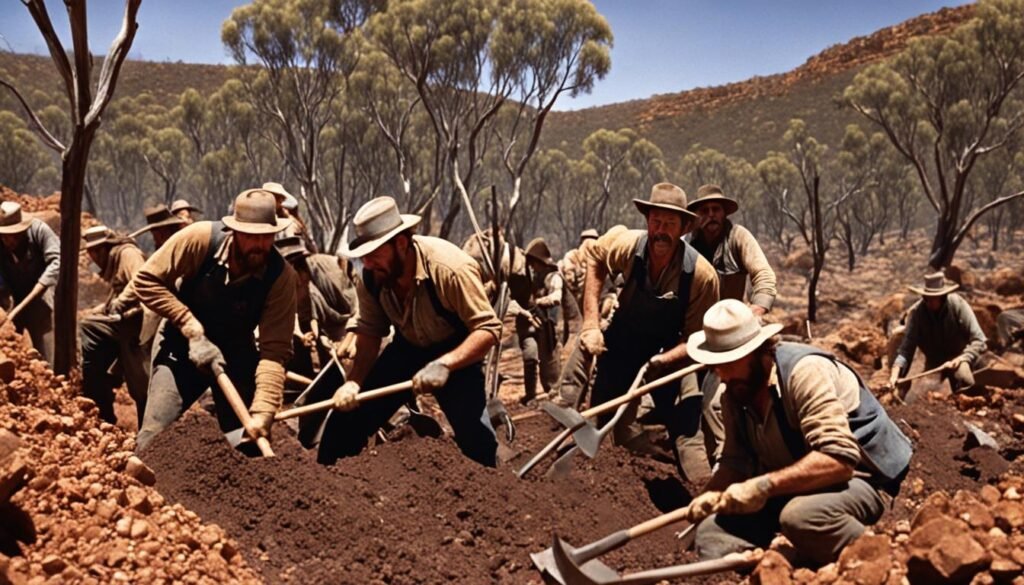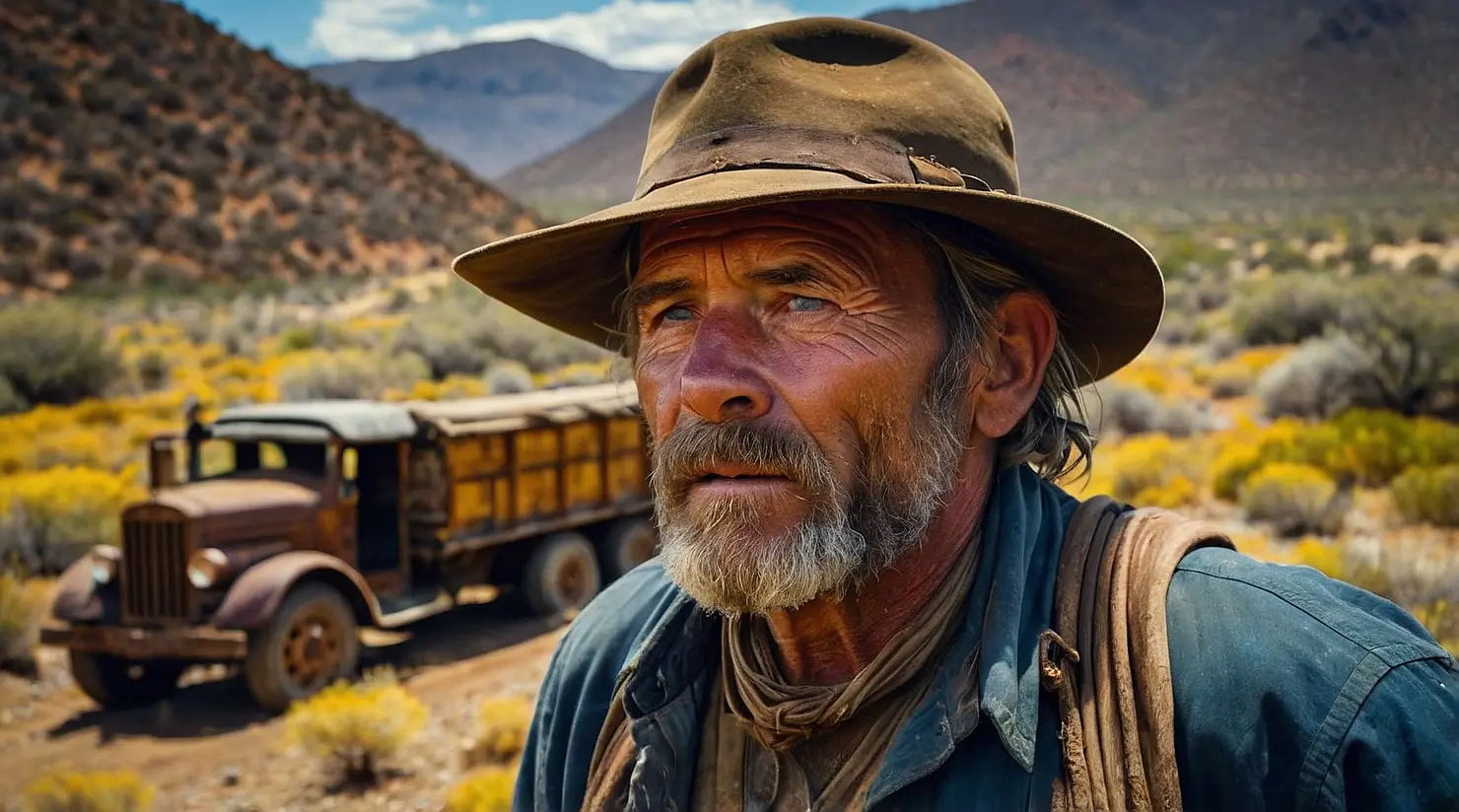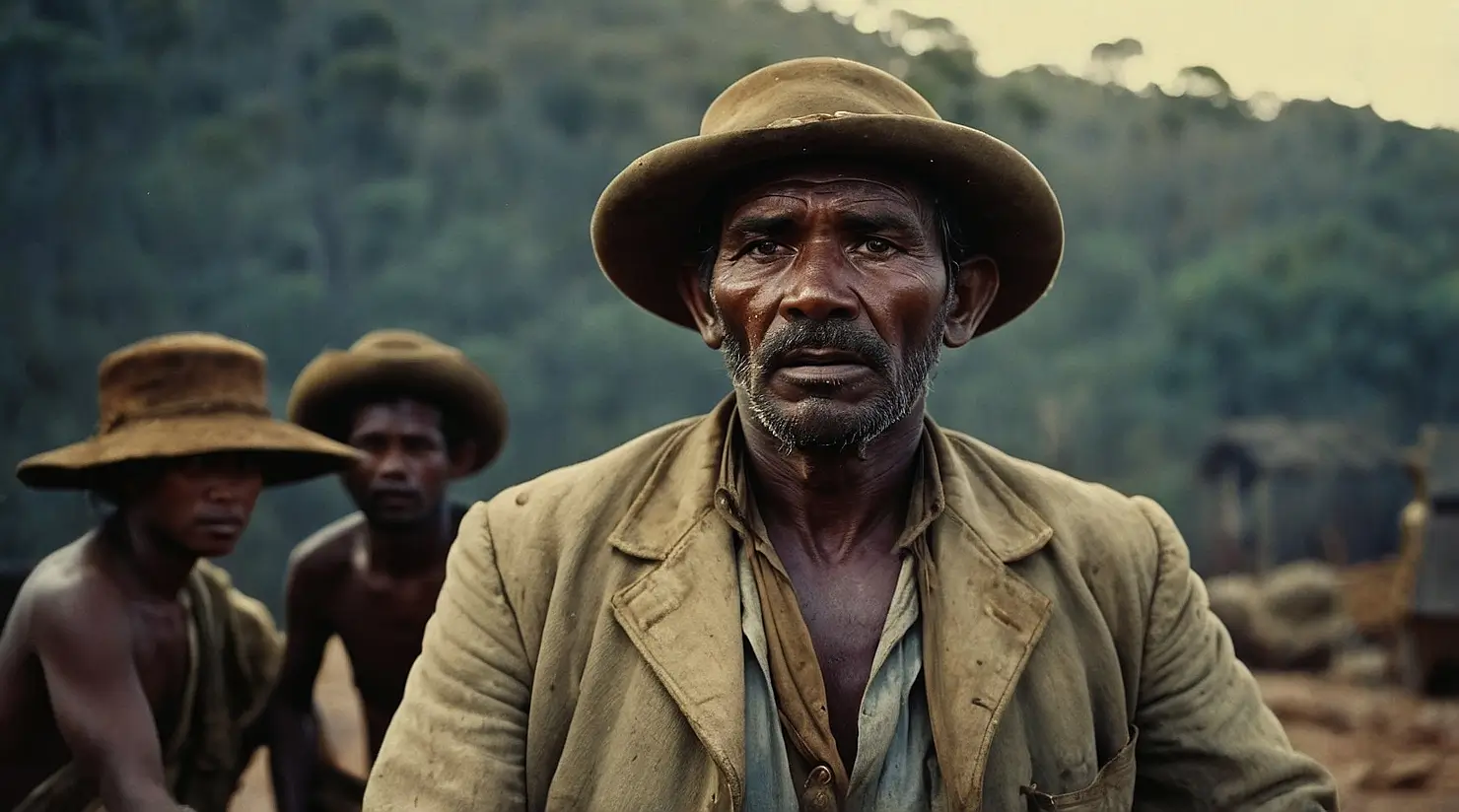Imagine going back in time to see the Australian gold rushes that thrilled the world in the 19th century. These events changed Australia, drawing prospectors from everywhere to its wild lands. They turned the country into a place of growth and wealth.
The gold rushes caused a big population increase. They also changed Australia’s economy and society. This made Australia known as a land of chances and finding wealth.
Key Takeaways: Australian Gold Rushes
- The Australian gold rushes, starting in 1851, were a significant event that changed the country’s colonies into more progressive and industrialized regions.
- Prospectors from within Australia and overseas flocked to areas where gold was discovered, leading to a population boom and the development of new cities and towns.
- The gold rushes played a pivotal role in contributing to Australia’s economic and social transformation, with the country becoming the largest producer of gold in the world by the end of the 19th century.
- The gold rushes attracted a diverse range of migrants, including from Britain, China, North America, and continental Europe, creating a multicultural melting pot.
- The discovery of gold led to the establishment of frontier towns and mining settlements, as well as the expansion of settlement across Australia.
Australian Gold Rushes: Striking It Rich Down Under
Prologue: The Lure of Gold
For centuries, the dream of finding gold has drawn people from all over the world. Before the famous California Gold Rush of 1848, gold prospecting was a big deal. It was a key part of the economy in places like colonial Australia.
Before the 1850s, gold was found in bits and pieces across Australia. But, the colonial governments kept this secret. They didn’t want the news to spread, fearing it would cause many workers to leave for the goldfields.
- But, the call of gold was too strong after the California Gold Rush started in 1848. Many Australians went to the U.S. to find their own gold.
- This made the government of New South Wales worried about losing workers. So, they asked the British Colonial Office to let them use the country’s gold. They even offered rewards for finding gold.
This set the stage for a big change in colonial Australia. Gold prospecting and mining would change the country’s economy, society, and people. It was the start of a golden future for Australia.
“The lure of gold has long captivated the human imagination, drawing people from all walks of life to the promise of untold riches and a chance to strike it rich.”
| Region | Significant Gold Discoveries | Time Period |
|---|---|---|
| Southern Africa | Rand area | Circa 1886-1896 |
| Western Australia | Kalgoorlie’s Golden Mile | Circa 1886-1896 |
Early Gold Discoveries and Government Suppression

Australia’s gold story began early, soon after Europeans arrived. In August 1788, James Daley, a convict, said he found gold in Sydney. But, he later admitted it was a lie. This didn’t stop many convicts from believing him, though the government was unsure.
Years went by, and more gold sightings were made in the Blue Mountains and the Bathurst region. In 1820, a Russian scientist, F. Stein, thought he saw gold ore in the Blue Mountains. Then, in 1823, James McBrien, an assistant surveyor, found gold in the Fish River near Bathurst. Yet, the government kept these finds secret, worried about the effect on the economy and society in the convict colonies.
Sightings in the Blue Mountains and Bathurst Region
Trying to find gold in the Blue Mountains and Bathurst was tough because of government doubt. In 1839, Paweł Strzelecki, a Polish explorer, found a bit of gold at the Vale of Clwyd near Hartley. Also, in 1837, gold and silver ore was found near Segenhoe, but the government ignored it. They were afraid of how it could change society and the economy.
Buy Gold Online: The Smart and Secure Way
Discover the safest and most reliable strategies to buy gold online. Make informed investment decisions and secure your financial future today!
Learn More“The colonial government continued to suppress these discoveries, fearing the potential impact on the economy and social stability of the convict colonies.”
The Golden Era Begins: 1851
In 1851, the Australian gold rushes started with a big discovery. Edward Hargraves, a prospector who came back from the California Gold Rush, found gold near Orange, New South Wales. He named the site Ophir. Using what he learned in California, Hargraves and his team found a lot of gold. This discovery started the Australian gold rushes.
Edward Hargraves’ Discovery at Ophir
The news of Hargraves’ find at Ophir spread fast, starting a gold rush across the country. Soon, gold was found in the Victoria colony too. By July 1851, the first gold rush was at the Clunes goldfield. Then, the rush moved to Ballarat and Castlemaine by early September.
The Victorian Gold Rush
The Victorian Gold Discovery Committee said the goldfields made the colony famous worldwide. It turned a remote area into the “richest country in the world” quickly. The Victorian gold rush was a big part of the world’s gold production in the 1850s. Australia became a key place for gold mining.
“The discovery of the Victorian goldfields had ‘converted a remote dependency into a country of world wide fame’ and made the colony the ‘richest country in the world’ within just a few years.”
The gold rushes changed Australia a lot. They brought many prospectors from around the world. This led to a big increase in the country’s population over the next decade.
Australian Gold Rushes

The Australian gold rushes from 1851 to 1893 changed the country’s history. These discoveries led to a big increase in population, economic growth, and social changes. They changed the Australian colonies in big ways.
The first gold find near Bathurst in 1823 started over 30 gold rushes across the country. These rushes happened in places like Ophir, Ballarat, Bendigo, and many others. They were a big deal for the economy and people.
These gold rushes brought a lot of people to Australia. At first, miners used simple tools like spades. But soon, big companies came with deep mines. This brought more people, making the population nearly four times bigger by 1871.
| Location | Gold Rush Dates |
|---|---|
| Clunes | 1851 |
| Castlemaine | 1851 |
| Ballarat | 1851 |
| Bendigo | 1851 |
| Coolgardie | 1892 |
| Kalgoorlie | 1893 |
| Gympie | 1867 |
| Charters Towers | 1872 |
The gold rushes made Australia a popular place for immigrants and investors. The gold money helped build things like railways. These railways connected cities to the goldfields, making some towns big centers.
Melbourne became Australia’s biggest city because of the gold. It was the main port for the Victorian goldfields. The gold rushes changed Australia from a convict place to a modern, industrial country.
New South Wales: Birthplace of the Rushes
The Australian gold rushes started in New South Wales. Before 1851, gold was found several times there. In the 1840s, British geologist Roderick Murchison thought New South Wales had lots of gold. His idea was right when gold was found in 1823 by James McBrien at Fish River, near Bathurst, in the Bathurst region of New South Wales.
William Tipple Smith’s Finds
In 1847, mineralogist William Tipple Smith found gold near Bathurst. But, the government didn’t pay much attention to it. Still, the gold discoveries in New South Wales drew people, setting the stage for the gold rush that changed the area.
Edward Hargraves’ Ophir Discovery
Edward Hargraves came back from the California Gold Rush and wanted to find gold in Bathurst. In 1851, he found gold in Lewis Ponds Creek, calling it Ophir. Even though his team found the big nuggets, Hargraves got the government reward of £10,000 for the find.
The gold discovery in New South Wales in May 1851 brought many people to Ophir. Soon, about 400 people were mining for gold. Many left their jobs in Sydney to join the gold rush, making Sydney seem emptier.
The Ophir town grew fast, becoming a busy place for gold seekers. People moved quickly to new goldfields as they were found. This included places like Sofala, Gulgong, Hill End, Bathurst, Lambing Flat (Young), Braidwood, Tilba Tilba, and Kiandra in the Snowy Mountains.
Victoria’s Golden Bounty
In the early 1850s, Victoria was facing an economic downturn. Many workers left their jobs to search for gold in New South Wales. The Victorian government then set up a Gold Discovery Committee. They offered a big reward for finding gold within 200 miles of Melbourne.
This move led to a rush of prospecting and exploration in Victoria. Discoveries were made by James Esmond near Clunes and James Regan and John Dunlop in Ballarat. These finds sparked the Victorian gold rush, attracting thousands from Europe, North America, and China.
Ballarat and Bendigo: Goldfields Extraordinaire
The goldfields of Ballarat and Bendigo were incredibly rich. Ballarat became the top alluvial goldfield in the world, finding huge nuggets like the “Welcome” nugget, which was about 152 pounds. This wealth made Victoria a leader in gold production in the 1850s.
| Goldfield | Remarkable Discoveries |
|---|---|
| Ballarat |
|
| Bendigo |
|
Today, Ballarat and Bendigo still celebrate their gold rush days. Ballarat’s Sovereign Hill museum shows the city’s early days after the 1851 gold find. Bendigo’s Golden Dragon Museum honors the Chinese miners who came to the area during the gold rush.
“The wealth of the Ballarat and Bendigo goldfields contributed significantly to Victoria’s dominance in global gold production during the 1850s.”
Queensland Joins the Gold Fever
While New South Wales and Victoria were booming from gold rushes, Queensland was also on the map. It was still part of New South Wales then. The government wanted to find gold in Queensland to bring in European settlers and grow the area.
The first big gold find was in Canoona, near Rockhampton, in 1858. This drew about 15,000 prospectors to the area, showing the intense gold fever. Then, in 1867, Gympie had a big find, bringing over 25,000 people to the region.
In the 1870s and 1880s, Queensland found more gold, especially in Charters Towers. Jupiter Mosman, an Aboriginal boy, found gold in 1871, starting the town of Charters Towers. By 1896, the town had 20,000 people, thanks to its rich gold.
| Location | Discovery Year | Population Influx | Gold Yield |
|---|---|---|---|
| Canoona | 1858 | 15,000 prospectors | – |
| Gympie | 1867 | 25,000 | – |
| Charters Towers | 1871 | 20,000 within 25 years | Up to 34 grams per ton |
Gold discoveries in Queensland added to the national gold fever. This brought in many prospectors and settlers. It helped grow the country fast and made Australia’s industries and infrastructure more diverse.
Western Australia’s Desert Treasures
In the mid-19th century, the eastern colonies of Australia were buzzing with gold fever. Western Australia, however, was different. Its vast, arid landscape was mostly unexplored. But, the 1880s brought a new era of gold discoveries that changed everything.
The Golden Mile of Kalgoorlie
The first big find was in 1886, in the Kimberley district, sparking a short-lived gold rush. Then, in 1887-88, the Pilbara and Yilgarn regions saw more promising discoveries. But the real breakthroughs came in 1892 with Arthur Bayley and William Ford’s Coolgardie find.
And in 1893, Paddy Hannan and his partners discovered the Kalgoorlie deposit, known as the “Golden Mile.” This area quickly became one of the richest places on Earth, producing up to 850,000 ounces of gold yearly.
Today, the Super Pit, one of the biggest gold mines, still mines the region’s wealth. It’s expected to find 40 million ounces of gold in the next decade.
The gold rush brought many prospectors from around the world. It turned small settlements into bustling towns. For example, Broad Arrow grew to 2,400 people by 1900, with many amenities. Now, it’s almost a ghost town, showing how fortunes can change.
Today’s gold diggers use advanced metal detectors and machines, unlike the old days. Yet, the search for desert treasures still draws people worldwide, hoping to strike it rich in this vast region.
“In 1892, two men in Western Australia’s desert collected 540oz of gold in a single afternoon, sparking a rush that quadrupled the region’s population within a decade.”
Impact on Population and Economy
The Australian gold rushes changed the country’s population and economy a lot. From 1851 to 1871, the population grew from 430,000 to 1.7 million. This was because many people from around the world came to the goldfields. They were mostly free immigrants, unlike the earlier convict colonies. This change helped make Australia more modern and industrialized.
The gold rushes also caused a big economic boom. By the 1850s, Australia was one of the wealthiest countries. Here are some key facts about this change:
- Thirteenfold increase in the value of Australian exports from 1851 to 1860.
- Threefold population increase from 1851 to 1860.
- Around a 70% increase in real wages by the end of the decade due to the gold rush.
- Per capita consumption of imports doubled from 1851 to 1860.
But, the fast economic transformation wasn’t all good. Some industries like beer and clothing saw a drop in production. This was because wages went up too fast. The gold rush also helped the banking, transportation, and equipment manufacturing sectors grow.
| Metric | 1851 | 1860 | Percent Change |
|---|---|---|---|
| Value of Exports | $5 million | $65 million | 1,200% |
| Population | 430,000 | 1,300,000 | 202% |
| Real Wages | Baseline | 170 | 70% |
| Per Capita Imports | $10 | $20 | 100% |
The gold rush era set the stage for Australia’s future success. It led to a big increase in population growth and economic transformation.
Multicultural Melting Pot
The Australian gold rushes in the 19th century drew people from all over, making the country a mix of cultures. Between 1852 and 1860, over 300,000 people came to Victoria, from the British Isles, Europe, and the U.S. But, those from non-European places, especially the Chinese, faced a lot of discrimination.
The Chinese Miners’ Experience
The Chinese were viewed as a threat because of their unique ways and looks. This led to strict immigration restrictions, like the Chinese Immigration Act of 1855 in Victoria. Yet, Chinese miners were a big part of the workforce, sometimes making up over one-fifth of men in some towns.
Getting to the Victorian gold fields was tough for many Chinese miners, who walked over 400 kilometers from places like Robe in South Australia. They faced racism and discrimination, with high taxes and restrictive laws trying to limit their chances.
Despite these challenges, some Chinese miners did well. They started businesses, married European women, and greatly added to Australia’s culture. Their story shows how they adapted, survived, and left a lasting mark on the country.
“The influx of wealth into the country completely transformed Australia, making Melbourne the world’s second-largest city, second only to London.”
| Statistic | Value |
|---|---|
| Chinese miners at the height of migration | Over one-fifth of the male population on the goldfields |
| Chinese miners who arrived in Victoria between 1854-1855 | Approximately 31,000 |
| Chinese goldseekers who walked over 400 km to reach Victorian gold fields | Around 17,000 |
The multicultural story of the Australian gold rushes shows the country’s rich and varied past. Despite facing a lot of racism and immigration restrictions, the Chinese miners made a big impact. Their hard work and resilience still shape Australia today.
For an overview about the Gold Rush Area, please check this guide.
Conclusion
The Australian gold rushes in the 19th century changed the country’s history. Many people moved to Australia, both from within and outside, because of the gold. This led to more people living there and the creation of new cities and towns.
The gold rushes also made the old convict colonies more modern and industrial. They helped turn the country into a more progressive place.
People on the goldfields shared stories and stood up against authority together. This created a strong national identity among the different groups of people.
Today, we still see the effects of the gold rushes in Australia. The country’s economy and society changed a lot because of it. It also shaped its national identity.
The gold rushes were a key time in Australia’s history. They led to more people, economic growth, and a unique national character. We can still see the effects of this time in Australia today. It’s a major part of why Australia is a leader in mining and resources worldwide.
FAQ about Australian Gold Rushes
What were the Australian gold rushes?
The Australian gold rushes were a series of events in the 1850s. They changed the country’s economy and population. Many people came from Australia and other places to search for gold.
This led to new cities and towns being built.
When did the Australian gold rushes begin?
They started in 1851. Edward Hargraves found gold near Orange, New South Wales, and called it Ophir. This discovery led to the gold rushes spreading to Victoria soon after.
What was the impact of the Australian gold rushes?
The gold rushes greatly affected Australia’s population and economy. From 1851 to 1871, the population grew from 430,000 to 1.7 million. People from all over the world came to the goldfields.
This led to a big economic boom, making Australia very wealthy in the 1850s.
How did the Australian gold rushes contribute to the transformation of the country?
The gold rushes changed Australia from a convict colony to a more modern and industrial place. The arrival of free immigrants made the country more diverse and prosperous.
What were some of the major gold discoveries during the Australian gold rushes?
The goldfields in Victoria, like Ballarat and Bendigo, were very rich. Ballarat was the top goldfield in the world at that time. Other big finds were in Western Australia, in places like the Kimberley and Coolgardie regions.
How did the Australian gold rushes impact the country’s multicultural identity?
The gold rushes brought people from many places, making Australia diverse. But, people like the Chinese faced a lot of discrimination. This led to laws that limited immigration from certain places.

Source Links
- https://www.kidcyber.com.au/gold-rush-in-australia
- https://digital-classroom.nma.gov.au/defining-moments/gold-rushes-begin
- https://kellycodetectors.com/blog/the-western-australia-gold-rushes/
- https://doi.org/10.1525/california/9780520294547.003.0006
- https://dx.doi.org/10.1525/california/9780520294547.003.0001
- https://www.slideshare.net/slideshow/rush-to-gold-the-french-and-the-california-gold-rush-18481854-pdfdrive-pdf-252453710/252453710
- https://en.wikipedia.org/wiki/Australian_gold_rushes
- http://stagoldrush.weebly.com/timeline.html
- https://mineralexpert.org/article/australian-gold-rush-mining
- https://www.nma.gov.au/defining-moments/resources/gold-rushes
- https://kids.britannica.com/students/article/Australian-gold-rushes/631682
- https://simple.wikipedia.org/wiki/Australian_gold_rushes
- https://sovereignhilledblog.com/2020/10/15/the-gold-rushes-of-victoria-and-california-compared/
- https://en.wikipedia.org/wiki/New_South_Wales_gold_rush
- https://www.sl.nsw.gov.au/stories/eureka-rush-gold/diggings-gold-rush
- https://www.bbc.com/travel/article/20120119-the-glittering-goldfields-of-southeastern-australia
- https://goldsecure.com.au/news/interesting-facts-about-the-australian-gold-rush/
- https://www.gainesvillecoins.com/blog/gold-nuggets
- https://goldoz.com.au/australian-gold-rush/
- https://kids.britannica.com/kids/article/Australian-gold-rushes/631737
- https://defenderadventure.com.au/the-goldfields/
- https://packs.eb.com.au/hss/custom/download/pack/pdf/421838
- https://www.independent.co.uk/news/world/australasia/the-outback-s-new-gold-rush-2283371.html
- https://studentjournals.anu.edu.au/index.php/aurj/article/download/171/130
- https://medium.com/@wagjihash/the-australian-gold-rush-shaping-a-nation-7c624013ed9f
- https://www.latrobe.edu.au/news/articles/2018/release/how-gold-rushes-helped-the-modernworld
- https://cod.pressbooks.pub/westernworlddailyreadingsgeography/chapter/pacific-realm-cultural-geography-i/
- https://library.norwood.vic.edu.au/c.php?g=949393&p=6882486
- https://victoriancollections.net.au/stories/many-roads-stories-of-the-chinese-on-the-goldfields
- https://academic.oup.com/book/34952/chapter/298575274
- https://www.tutorchase.com/answers/ib/history/how-did-the-australian-gold-rushes-affect-global-migration
- https://colitco.com/striking-gold-exploring-the-history-of-australias-gold-rush/


